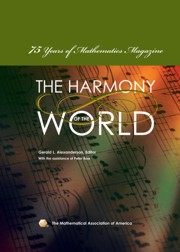Book contents
- Frontmatter
- Introduction
- Contents
- A Brief History of Mathematics Magazine
- Part I The First Fifteen Years
- Part II The 1940s
- The Generalized Weierstrass Approximation Theorem
- Hypatia of Alexandria
- Gauss and the Early Development of Algebraic Numbers
- Part III The 1950s
- Part IV The 1960s
- Part V The 1970s
- Part VI The 1980s
- Briefly Noted
- The Problem Section
- Index
- About the Editors
The Generalized Weierstrass Approximation Theorem
from Part II - The 1940s
- Frontmatter
- Introduction
- Contents
- A Brief History of Mathematics Magazine
- Part I The First Fifteen Years
- Part II The 1940s
- The Generalized Weierstrass Approximation Theorem
- Hypatia of Alexandria
- Gauss and the Early Development of Algebraic Numbers
- Part III The 1950s
- Part IV The 1960s
- Part V The 1970s
- Part VI The 1980s
- Briefly Noted
- The Problem Section
- Index
- About the Editors
Summary
Editors' Note: Marshall Harvey Stone was one of the leading American mathematicians of the mid-twentieth century. Educated at Harvard—his PhD advisor was G. D. Birkhoff—he joined the faculty there after short appointments at Columbia and Yale. In 1946 he was brought to the University of Chicago to revitalize the Mathematics Department there. Thus he ushered in the often-cited “Stone Age” at Chicago, attracting such senior faculty as S. S. Chern, Saunders Mac Lane, André Weil, and Antoni Zygmund, as well as a younger group that included Paul R. Halmos, Irving E. Segal, and Edwin H. Spanier, who joined existing faculty Irving Kaplansky and A. A. Albert.
Stone was the son of the U. S. Supreme Court Chief Justice (1941–46), Harlan Fiske Stone,who is reported to have said, “I am puzzled but happy that my son has written a book of which I understand nothing at all.”
The classical Weierstrass approximation theorem asserts that any continuous function on a closed interval [a, b] can be uniformly approximated there by a polynomial function. This theorem can be reformulated in terms of the algebra C([a, b]) of all continuous functions on [a, b], which contains as a subalgebra the family P of all polynomials in a single variable x. C([a, b]) is a complete metric space under the so-called supremum norm, where the distance between two continuous functions f and g is maxx∈[a,b]|f(x) - g(x)|.
- Type
- Chapter
- Information
- Harmony of the World75 Years of Mathematics Magazine, pp. 35 - 44Publisher: Mathematical Association of AmericaPrint publication year: 2007



